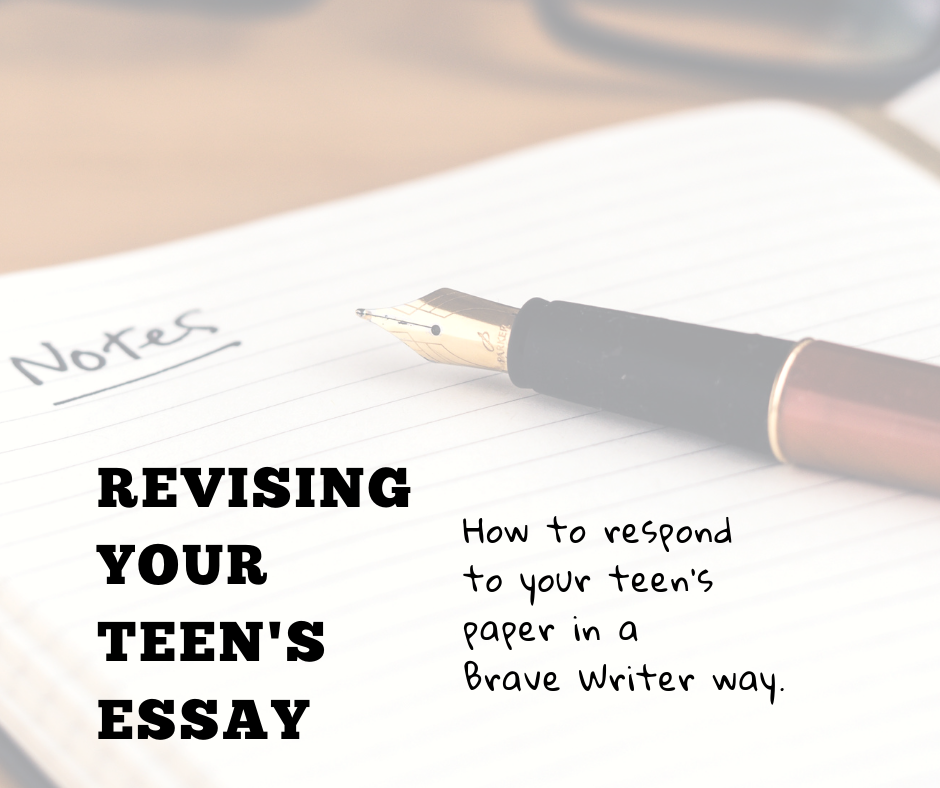Essay revision is a significant stage in the writing process. Don’t be surprised if more time is spent in this stage than writing the original draft. It’s a risky stage too. This is when the Red Pen Monster rears its ugly head. Watch for it because it will make you want to do this…

And/or this…

BTW, you’re the one responsible for teaching them, so if their essay is a hot mess of teenage rants, it’s a direct reflection on you, right?! Wrong! But that’s what the voice in our head whispers.
We know neither response is productive. But how does a homeschool mom respond to a hot mess of a first draft? (And first drafts are often hot messes.)
Wait 24 Hours
It helped me to take twenty-four hours between reading their paper and drafting my feedback. I found I was more objective and problems didn’t seem as personal after a good night’s sleep. As I’ve gained more experience with this, I find it easier to respond in a shorter time frame, but take that twenty-four hours in the beginning.
Prime Your Mindset
During your twenty-four hour wait period, read these Brave Writer blog posts to help prime your mindset as your teen’s editor.
Find the Good
After your twenty-four hours and you read their draft the second time, you MUST find and note what’s good/right about the essay. Easier said than done when you can’t help but see the glaring (to you) grammar mistakes, clunky paragraphs and underdeveloped ideas. But you have to find it. Maybe it’s a nugget of an idea, an interesting perspective that has potential (even if you disagree with it), a half-baked but good rebuttal. Maybe it’s a great use of alliteration or a metaphor or sophisticated vocabulary.
Do not move forward in revision until you can find something to sincerely praise.
Read The Writer’s Jungle Chapter 7.
Yes, that chapter in The Writer’s Jungle talks mostly about revising a freewrite, not an essay’s first draft, but many of the ideas still apply, such as…
- “Start with one thing” section, page 82. At the essay level, I put clarity of thought before anything else. That’s my “one thing.” Is their content clear in a way a someone can follow their train of thought & point being made? Are the supporting sentences relevant to the paragraph topic? Does it communicate well to the reader? To coach clarity of thought, continue looking at…
- Four Principles of Revision (pages 83-85). Main idea = paragraph topic. Principle #2 addresses that clarity of thought.
- Snip & Pin advice on page 86 still works with teens.
- Mediocre reporting (page 87) explains how to expand a weak or vague topic paragraph.
- Awkward phrasing (page 89) also works on achieving that clarity of thought.
I personally tackle revision one paragraph at a time so my teens don’t feel like their entire essay is one mistake after another. That means revision can take us 5 days, even longer when you count your time to read the draft and respond positively. What to correct, what needs prioritizing and what can wait to be addressed in the next essay are all decisions that take time. We want to respond thoughtfully and not correct every single problem in an essay.
Only after clarity of thought and organization are cleaned up do I then tackle grammatical errors in the paper. Unless a grammatical error impedes clarity of thought, grammar clean up is the last step in revision.
Use Jot It Down Techniques
Don’t hesitate to use Jot It Down techniques with your teen as you discuss revision and ask clarifying questions. Jot It Down isn’t just for young kids still learning their ABCs. Remember, crafting more complex, nuanced thoughts and writing them at the same time is a new skill for teenagers. The pedals in the brain controlling both their new complex thinking skills and written expression may not be in sync yet. Male brains in particular are slower to mature in the area responsible for organization, sometimes not until the mid-twenties.
While they are in this new stage of writing growth, it is perfectly fine for you to step in with support and help them capture their original thought. If they are struggling or feeling frustrated, jot down their words as they answer your questions about their paper. Then hand it back to them to type up in their essay. It’s still their words and ideas; you only helped capture it. They will eventually mature into this skill.
Read The Writer’s Jungle Chapter 15
Particularly pages 177-79 can also help expand those underdeveloped paragraphs.
The Writer’s Jungle Chapter 10 – The Top Ten Writing Elements
Once clarity of thought is accomplished and your teen is ready to tackle more sophisticated revision (either they have advanced enough that clear thoughts flow more easily for them, or they have the energy to continue refining their paper), look at this particular section of chapter 10. Can you pick one or two elements and incorporate them into the draft? I personally don’t worry about adding any of these on their first expository essay. If I find them in the essay simply because they naturally occurred in their draft, high-five your teen and hand them an extra brownie!
Bake Brownies
Have a fun treat, whatever that is for your family, to share as you review your feedback and revision notes with your teen. Maybe it’s brownies. Maybe it’s kale chips, but keep in mind countries who eat the most chocolate also have the most Nobel Prize winners. I’m going with chocolate.
Even when you start your feedback with what’s right about their paper, it’s still hard to hear an editor point out what’s wrong. Treats help.
Evaluation Rubric
If you own Help for High School, it has a rubric you can use on pages 157-59. This will help you pinpoint what needs revising.
Additional resources I use during the revision stage
They Say I Say: The Moves That Matter in Academic Writing.
I have this exact edition linked. (Not an affiliate link.) As I’ve said before, it’s been worth every penny I spent.
Analyzing Quotes & Facts booklet
A handy dandy notebook to help with embedding quotes and research along with student commentary. No more paragraphs that are only strings of quotes, facts or paraphrasing. It helps your teen include their own commentary in response to the research and quotes.
The booklet also has reminders on citing particular sources (books vs. articles vs. websites with no author). The download includes a graphic organizer covering the steps to embed a quote/research, which can help visual learners pull an abstract concept down to reality where they can “see” the thinking process.
If you’re on Facebook, you can find more support for using Brave Writer with teens at the parent-led Brave Schooling with Teens group. There’s also the larger Brave Writer sponsored Facebook group where you can ask questions too.
If your teen struggles with high school level writing due to any learning disabilities, many parents find it helpful to pull in professional help. Rooted in Language works with struggling writers, and the founder homeschooled her children too. They do offer online therapy sessions.

*No affiliate links or sponsorship from any of the products or companies I listed in this post. I purchased all of these products myself.


